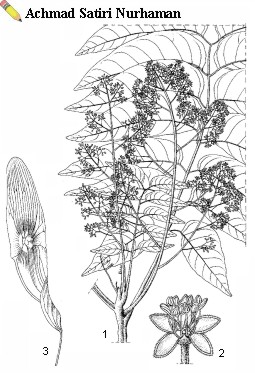Record Number
111
PROSEA Handbook Number
5(2):Timber trees; Minor commercial timbers
Taxon
Ailanthus integrifolia Lamk
This article should be read together with the article on the genus: Ailanthus in the Handbook volume indicated above in this database.
This article should be read together with the article on the genus: Ailanthus in the Handbook volume indicated above in this database.
Protologue
Dict. 3(2): 417 (1792).
Synonyms
Ailanthus moluccana DC. (1825), Ailanthus blancoi Merr. (1918), Ailanthus peekelii Melch. (1930).
Vernacular Names
Indonesia: ai lanit (Moluccas), kayu ruris (Minahassa), pohon langit (Ambon). Philippines: malasapsap (general), balokas, makaisa (Tagalog).
Distribution
Western India (Assam), southern Vietnam, throughout Malesia (except for the Lesser Sunda Islands) towards the Bismarck Archipelago and the Solomon Islands.
Uses
The wood is used as white siris; it is also used for local house building and furniture manufacture.
Observations
A large tree up to 60 m tall, bole branchless for up to 35 m, up to 85(-175) cm in diameter, bark surface smooth or irregularly fissured, pale brown or greyish; leaves with 2-9 entire leaflets 10-40 cm long, lower surface sometimes pubescent and with a few large black glands; petals puberulous, carpels 5; fruit 11-22 cm long. Ailanthus integrifolia is divided into two subspecies: subsp. integrifolia and subsp. calycina (Pierre) Nooteboom. The former has up to 15 mm long pedicels and 6-10 mm long petals and occurs in primary rain forest up to 900 m altitude throughout Malesia except for Java and the Lesser Sunda Islands and on the Bismarck Archipelago and the Solomon Islands. The latter has pedicels up to 5 mm long and petals c. 4 mm long and occurs in mixed seasonal primary forest in western India, southern Vietnam and Java. The density of the wood is 330-390 kg/m³ at 12% moisture content. See also the table on wood properties.
Image
 | Ailanthus integrifolia Lamk – 1, flowering twig; 2, male flower; 3, fruit. |
Selected Sources
All Nippon Checkers Corporation, 1989. Illustrated commercial foreign woods in Japan. Shinagawa-ku, Tokyo. 262 pp.
Beniwal, B.S. & Singh, N.B., 1990. Genetic improvement of forest trees in Arunachal Pradesh, India. Indian Forester 116(1): 3-10.
Bolza, E. & Kloot, N.H., 1966. The mechanical properties of 81 New Guinea timbers. Technological Paper No 41. Division of Forest Products, CSIRO, Melbourne. 39 pp.
Eddowes, P.J., 1977. Commercial timbers of Papua New Guinea, their properties and uses. Forest Products Research Centre, Department of Primary Industry, Post Moresby. xiv + 195 pp.
Flora Malesiana (various editors), 1950-. Kluwer Academic Publishers, Dordrecht, Boston, London.
Hellinga, G., 1950. Houtsoorten voor aanplant op bedrijfsgrootte [Forest tree species for planting on a large scale]. Tectona 40: 179-229.
Hellinga, G., 1950. Resultaten van de proeftuinen voor boomgewassen sedert 1937. Loofhoutsoorten II [Results from trial plots for trees since 1937. Deciduous trees II]. Rapport No 27. Bosbouwproefstation, Buitenzorg. 29 pp.
Hewson, H.J., 1985. Simaroubaceaea. Flora of Australia. Vol. 25, Melianthaceae to Simaroubaceae. Australian Government Printing Service, Canberra. pp. 188-197.
Merrill, E.D., 1923-1926. An enumeration of Philippine flowering plants. 4 volumes. Bureau of Printing, Manila.
Reyes, L.J., 1938. Philippine woods. Technical Bulletin No 7. Commonwealth of the Philppines, Department of Agriculture and Commerce. Bureau of Printing, Manila. 536 pp. + 88 plates.
Whitmore, T.C. & Ng, F.S.P. (Editors), 1972-1989. Tree flora of Malaya. A manual for foresters. 2nd edition. 4 volumes. Malayan Forest Records No 26. Longman Malaysia SDN. Berhad, Kuala Lumpur & Petaling Jaya.
Working group on utilization of tropical woods, 1978. Properties of some Papua New Guinea woods relating with manufacturing processes VI-IX. Bulletin of the Forestry and Forest Products Research Institute Japan No 299: 23-187.
Beniwal, B.S. & Singh, N.B., 1990. Genetic improvement of forest trees in Arunachal Pradesh, India. Indian Forester 116(1): 3-10.
Bolza, E. & Kloot, N.H., 1966. The mechanical properties of 81 New Guinea timbers. Technological Paper No 41. Division of Forest Products, CSIRO, Melbourne. 39 pp.
Eddowes, P.J., 1977. Commercial timbers of Papua New Guinea, their properties and uses. Forest Products Research Centre, Department of Primary Industry, Post Moresby. xiv + 195 pp.
Flora Malesiana (various editors), 1950-. Kluwer Academic Publishers, Dordrecht, Boston, London.
Hellinga, G., 1950. Houtsoorten voor aanplant op bedrijfsgrootte [Forest tree species for planting on a large scale]. Tectona 40: 179-229.
Hellinga, G., 1950. Resultaten van de proeftuinen voor boomgewassen sedert 1937. Loofhoutsoorten II [Results from trial plots for trees since 1937. Deciduous trees II]. Rapport No 27. Bosbouwproefstation, Buitenzorg. 29 pp.
Hewson, H.J., 1985. Simaroubaceaea. Flora of Australia. Vol. 25, Melianthaceae to Simaroubaceae. Australian Government Printing Service, Canberra. pp. 188-197.
Merrill, E.D., 1923-1926. An enumeration of Philippine flowering plants. 4 volumes. Bureau of Printing, Manila.
Reyes, L.J., 1938. Philippine woods. Technical Bulletin No 7. Commonwealth of the Philppines, Department of Agriculture and Commerce. Bureau of Printing, Manila. 536 pp. + 88 plates.
Whitmore, T.C. & Ng, F.S.P. (Editors), 1972-1989. Tree flora of Malaya. A manual for foresters. 2nd edition. 4 volumes. Malayan Forest Records No 26. Longman Malaysia SDN. Berhad, Kuala Lumpur & Petaling Jaya.
Working group on utilization of tropical woods, 1978. Properties of some Papua New Guinea woods relating with manufacturing processes VI-IX. Bulletin of the Forestry and Forest Products Research Institute Japan No 299: 23-187.
Author(s)
M.S.M. Sosef
Correct Citation of this Article
Sosef, M.S.M., 1995. Ailanthus integrifolia Lamk. In: Lemmens, R.H.M.J., Soerianegara, I. and Wong, W.C. (Editors): Plant Resources of South-East Asia No 5(2):Timber trees; Minor commercial timbers. PROSEA Foundation, Bogor, Indonesia. Database record: prota4u.org/prosea

All texts are licensed under a Creative Commons Attribution-Noncommercial-Share Alike 3.0 Netherlands License
This license does not include the illustrations (Maps,drawings,pictures); these remain all under copyright.